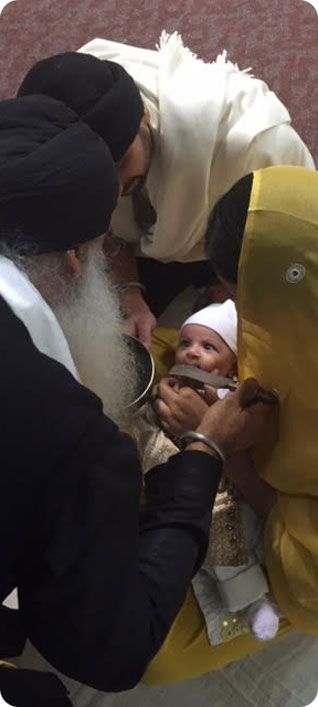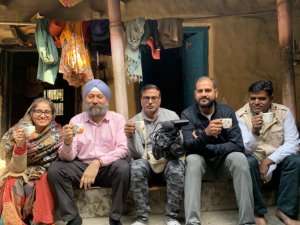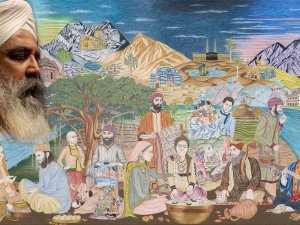Welcoming Our Newborn To The Sikh Fold
 August 14, 2015: On Saturday August 8, 2015, our latest addition to the family, my grandson Khiaan Singh -- son of my middle daughter Harsel Kaur and her husband Navinder Singh -- was formerly brought into the Sikh fold.
August 14, 2015: On Saturday August 8, 2015, our latest addition to the family, my grandson Khiaan Singh -- son of my middle daughter Harsel Kaur and her husband Navinder Singh -- was formerly brought into the Sikh fold.
It is a ceremony called the Janam Sanskar - the initial rites of a new born.
I find it a very moving ceremony which is still practised by Sikhs in Malaysia and Singapore, but it does not seem to be as prevalent elsewhere in the diaspora.
Yes, we also have a Naming Ceremony when a child is born, called 'Naam Dharna', but it is not the same as Janam Sanskar.
The Sikh Encyclopedia does make a reference to it on Vol 3, pp 163-65, under the heading "Namkaran". It says that when a child is born in a Sikh family the baby is brought to a gurdwara.
"The ministering granthi or any other revered Sikh will mix amrit stirring it with a kirpan and reciting the first five stanzas from Japji. Ardaas is then said."
In Malaysian in practice, the 'naming ceremony' - the Naam Dharna is normally carried out almost immediately after the birth where the father, or another close family member, goes to the Gurdwara Sahib. The Granthi Sahib, after ensuring body cleanliness, or taking an 'ishnaan' again, makes degh, does an ardaas and then takes a Hukmnama.
The first letter of the first word of the Hukmnama is then used to find a name for the child; that is, a name which begins with that letter.
Degh is then served and also taken back to the hospital for the mother and served to others there.
The Janam Sanskar is normally carried out about 40 days after birth when the mother is able to move about and take her newborn to the gurdwara for this ceremony. This is normally done in the presence of sangat
The Rehat Maryada is silent on the Janam Sanskar.
We carried out my middle daughter's Anand Kaaraj last year at our new premises just outside Melbourne, Australia. The next 'service' has, with the grace of Waheguru, turned out to be her first born's Janam Sanskar.
We had started a Sehaj Paatth after my daughter's Anand Kaaraj last year and coincidently that was the day that she found out that she was expecting. So it was only fitting that the Paatth da Bhog was going to be done on the Janam Sanskar.
 The occasion was graced by about 90 friends and relatives from Sydney, Adelaide, Canberra and, of course, Melbourne.
The occasion was graced by about 90 friends and relatives from Sydney, Adelaide, Canberra and, of course, Melbourne.
We started the service with the Paatth da Bhog. The occasion was then graced by kirtan by the youth 'jathha' of Sikh Youth Australia (SYA) from Sydney who happened to be in town.
(SYA holds two major events in Sydney annually - the Sikh Youth Leadership Camp in July and the Sikh Family Camp in January. I have a long term involvement with this organisation.)
The ceremony was carried out by Bhai Sarjit Singh, one of our Guru-ke-sevadars from Melbourne. He also, of course, originates from Malaysia!
The ceremony started with a short 'ardaas' when the parents of the newborn, carrying the child, stand up. The rest of the sangat remains seated.
We decided to have softly sung Waheguru 'naam simran' in the background which lent a very spiritual, poignant and moving atmosphere to the occasion.
Sarjit Singh Ji, dressed in full black as he usually is, with a kesri 'kamarkassa' (yellow sash tied around his waist) knelt down in bir aasan, and stirred sugar cakes (pataasay) in water in a cast iron bowl with a small khanda, all the while reciting the Japji Sahib.
On completion, he stood up and did another small ardaas, after which he administered five drops of the amrit from the edge of the khanda into Khiaan's mouth, each time reciting ‘Waheguru ji ka Khalsa, Waheguru ji ki Fateh. A mouthful of this 'amrit' was then consumed by the parents.
Sarjit Singh ji then said a few words to the parents reminding them of their Guru-given duty of bringing up their child in GurSikhi, the importance of Gurmukhi and also the importance of 'kesh' (unshorn hair) as the prominent Sikh identity, and grooming their child for amrit when he comes of age.
He then asked if anyone else from the sangat, especially the children, would like to drink a drop of this amrit.
The ceremony concluded with a 'jakara'.
We then had about half an hour of kirtan, concluding with Anand Sahib, Ardaas and the Hukamnama.
The whole service was completed within two hours, and was followed by Guru ka Langar.
A non-Sikh asked about the use of the khanda (or kirpan) to administer the drops of amrit. My explanation is that it signifies the 'sipahi' (soldier), the temporal aspect, half of the 'sant-sipahi' (saint-soldier) philosophy of Sikhism.
Judging from comments from sangat members, especially those who have never witnessed this ceremony, and the non-Sikhs present, I believe that this ceremony is of great importance as part of our culture as a means of showing the importance of our way of life, especially to our younger generations.
I believe that through the Janam Sanskar, we have a very important ceremony as a way of our children remembering, being reminded, and attaching themselves to the Guru.
'Keeta lorriye kumm so har pai akheeye'. We approach and request Waheguru for His blessings at all the important cornerstones of our lives, and this is the first one.
We all wish Khiaan Singh a long, prosperous and healthy life. But we also pray that he finds strength and sustenance in Sikhi and in Guru Sahib, and that he feels a sense of belonging to the Sikh fraternity worldwide. We hope and pray that he is always there in seva, in Naam, and in turn invokes the blessings and Grace of the Guru.
'Sukhi vasai moro parvara / sevak sikh sabhai kartara …'
* * * * *
For a fuller explanation of ‘Namkaran’, please CLICK here.





